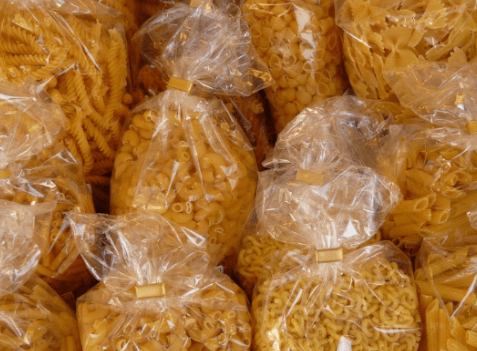With eco-friendly packaging being considered as part of the green product decision-making process of today’s customers, here we look at food packaging that could save on plastic waste because it is edible!

Edible Food Packaging
The concept of edible food packaging is not new and has been around for centuries in the form of natural materials like leaves, fruits, and vegetables used to wrap food. However, the first commercial edible packaging was developed in the early 21st century.
In 2010, a company called WikiCell Designs, Inc. developed the first edible food packaging made from natural ingredients like fruits, vegetables, and nuts. The packaging consisted of a thin edible membrane that could be filled with liquids or semi-solids like ice cream, yogurt, or beverages.
Since then, other companies have also developed edible food packaging, such as Skipping Rocks Lab’s “Ooho” which is made from seaweed extract and can hold water or other liquids, and Loliware’s “HyperChiller” which is a coffee cup made from a seaweed-based material that can be eaten after use.
What Are The Benefits Of Edible Food Packaging?
Some of the main benefits of producing edible food packaging include:
Reducing plastic waste
Edible food packaging has the potential to significantly reduce the amount of plastic waste generated by traditional packaging materials. This is because edible packaging can be consumed after use, eliminating the need for disposal.
Sustainability
Edible packaging made from natural ingredients can be more sustainable than traditional packaging materials, which are often made from non-renewable resources.
Convenience
Edible packaging can be a convenient option for on-the-go consumption, eliminating the need for additional utensils or packaging.
Novelty
Edible packaging can be a unique and interesting way to package food, which can be a selling point for certain products.
Health benefits
Some types of edible packaging can even provide additional health benefits, such as fibre or vitamins from the natural ingredients used to make the packaging.
Examples Of Edible Food Packaging Available Now
Some prominent examples of edible food packaging manufacturers include:
Notpla
Notpla (a play on the term ‘Not Plastic’) says it is “on a mission is to make packaging disappear and are focused on providing sustainable alternatives to single-use packaging through the use of seaweed and plants.” Its edible, seaweed-based food packaging is described as being “neither plastic nor bioplastic. “ Notpla’s products include:
Ooho:
Created for drinks and designed to be 100 per cent edible.
Notpla Film:
Designed to replace conventional fossil-derived, and bioplastic based, flexibles, and will breakdown naturally without releasing any microplastics.
Notpla Paper:
Made from the fibres and biomass of seaweed, this paper enables a new circular way for Notpla to use entire seaweed and creates an eco-friendly, edible alternative to normal paper.
Evoware
Also mostly seaweed based, Evoware’s products include biodegradable, home compostable, and planet friendly packaging products like bags and mailers, sachets and wrappings, straws and cups, food containers and cutlery. Evoware also makes packaging products from rice, cassava, sugar cane, bamboo, birchwood, and the leaves of Areca palm trees. Edible packaging products from Evoware include ‘Ello Jello cups’ made in different colours and with different flavours such as peppermint, orange, lychee, and green tea. Also, Evoware make edible food wraps and edible sachets which are odourless, tasteless, and biodegradable.
Traceless
Traceless says it envisions “a world where the materials we use impact positively on the planet, rather than leading to pollution and waste.” In line with this vision, it makes naturally compostable and edible packaging out of biopolymers which have been extracted from plant residues and by-products of agricultural food production. An example of the German company’s edible packaging include edible ‘plastic’ films and coatings made entirely from plant residue, which are also completely compostable, so if they end up in the environment or oceans, they break down completely into CO2 and H2O, leaving no residues, or can be eaten by animals with no ill-effects.
What Does This Mean For Your Organisation?
The huge environmental problem of plastic waste pollution and microplastics in the seas and water supplies, plus mountains of other non-biodegradable or compostable and toxic food packaging waste poses a huge challenge.
Creating edible and sustainable packaging alternatives, as the above-named companies (and others) are doing, is an innovative way of reducing the environmental burden of food packaging and its manufacture, and of creating more of a circular and sustainable packaging production model. Edible packaging manufacture may also present exciting new opportunities for many businesses and start-ups.
While still in the early stages of development, edible food packaging, therefore, has the potential to reduce plastic waste and provide a sustainable alternative to traditional packaging materials, yet there may be challenges to overcome in terms of scalability, cost-effectiveness, and food safety. Additionally, not all types of food can be packaged using edible packaging, as some foods may require more durable or moisture-resistant packaging materials.
By Mike Knight
